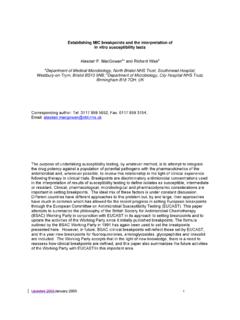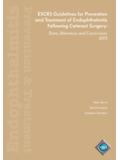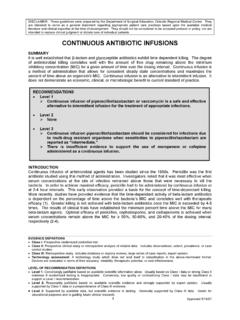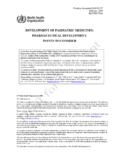Transcription of Fluoroquinolone Use in Paediatrics: Focus on Safety and ...
1 118th Expert Committee on the Selection and Use of Essential Medicines (2011) Fluoroquinolone Use in Paediatrics: Focus on Safety and Place in Therapy Jennifer A. Goldman, 1,2, Gregory L. Kearns, , 1,3,4 Departments of Pediatrics 1 and Pharmacology 3, University of Missouri Kansas City and the Divisions of Pediatric Infectious Disease 2 and Clinical Pharmacology and Medical Toxicology, 4 Children s Mercy Hospital, Kansas City, MO, USA Commissioned work for the Guidelines Group for the Revision of the Guidance for National Tuberculosis Programmes on the Management of Tuberculosis in Children , World Health Organization, 30-31 March 2010, Geneva, Switzerland 2I.
2 introduction The first quinolone, nalidixic acid, was developed in the 1960s and was used (off-label) in pediatric therapeutics without restriction. Consequent to their broad spectrum of antimicrobial (including anti-mycobacterial) effect and perceived excellent Safety profile, there was considerable hope and expectation that this class of antibiotics would find an important place in pediatric therapeutics. However, reports of quinolone-associated injury in weight bearing joints of juvenile animals resulted not only in an apparent contraindication to their use in human infants and children but also, completely derailed their formal development by pharmaceutical companies for use in pediatrics.
3 While this situation resulted from a genuine concern for Safety seemingly supported by relevant experimental findings, it served initially to remove a potentially useful class of antimicrobial agents from pediatric use. Despite the concerns associated with Fluoroquinolone use in children, the favorable characteristics of this drug class (eg., excellent oral bioavailability and tissue penetration, broad antimicrobial spectrum, well characterized and predictable concentration-effect relationships, relative low incidence of development of microbial resistance) resulted in their increasing use in infants and children; initially as secondary or tertiary antimicrobial choices and three decades later, as a potential first line modality of treatment recommended in standard pediatric compendia used throughout the world (eg.)
4 , ciprofloxacin monographs in Medicines for Children, Royal College of Paediatrics and Child Health and Neonatal and paediatric Pharmacists Group, 2003; Pediatric Dosage Handbook, 16th edition, Lexicomp Corporation, 2009). For example, previous recommendations from the American Academy of Pediatrics (Red Book, 28th edition, American Academy of Pediatrics, 2009) indicate that fluoroquinolones may be useful for treating infections in pediatric patients where no other (appropriate) oral agent is available, the infection is caused by a multidrug-resistant pathogen (such as Pseudomonas sp. and Mycobacterium strains) or prolonged oral treatment of gram-negative bacterial infections (eg.
5 , chronic osteomyelitis, exacerbations in patients with cystic fibrosis, infections in immunocompromised patients) is needed. Consequently, there appears to now be a real place in the pediatric therapeutic armamentarium for this class of antimicrobial agents. However, an overriding caveat for their use in children continues to entail a critical assessment of the risk vs. benefit ratio where adverse event data derived from animal models may not be completely/accurately extrapolated to developing humans. The purpose of this review of the fluoroquinolones is to synthesize available information of pertinence with respect to their use in children.
6 The pharmacokinetics and pharmacodynamics of the drugs will be discussed as well as their general Safety profile and the current and potential future roles for representative agents in this class in treating serious infections that can commonly occur in infants and children. II. Clinical Pharmacology Fluoroquinolones are a class of antimicrobials that selectively target the action of bacterial topoisomerase II and IV. Inhibition of the activity of these enzymes disables DNA replication which in turn, inhibits bacterial replication. Presently, four generations of Fluoroquinolone antibiotics exist as illustrated by the following table: 3 First generation nalidixic acid Second generation ciprofloxacin, levofloxacin, enoxacin, fleroxacin, ofloxacin, lomefloxacin, norfloxacin Third generation gatifloxacin, gemifloxacin, grepafloxacin, sparfloxacin Fourth generation moxifloxacin, trovafloxacin Of these agents, ciprofloxacin, levofloxacin, gatifloxacin and moxifloxacin are the most widely The mechanism of action for the fluoroquinolones conveys activity that is bactericidal in nature.
7 They have activity against a broad range of gram positive and negative organisms. The drugs in this class are uniformly active against the Enterobacteriaceae, and many strains of Listeria, Chlamydia, and mycobacteria. The newer quinolones have enhanced activity against staphylococci, streptococci and In general, the older generation compounds have more activity against gram negative bacteria and provide less gram positive coverage. The converse is true with 3rd and 4th generation fluoroquinolones which demonstrate an expanded spectrum against gram positive organisms. In regards to their activity against Mycobacterium tuberculosis, moxifloxacin and gatifloxacin demonstrate more potent in vitro activity than ciprofloxacin or Expanded use of the fluoroquinolones brings with it increasing concern for the development of microbial resistance.
8 There are several potential mechanisms for the development of resistance. These include the development of mutations in the genes that encode bacterial topioisomerase II and IV (which result in altered binding affinity of the drug and reduced action) and the development of bacterial efflux transporters (which reduce intracellular drug exposure). A plasmid carrying the gene qnrA has also been discovered which leads to an inherent mechanism of As with most antimicrobial agents, a primary determinant of Fluoroquinolone efficacy resides with obtaining a sufficient exposure of the offending pathogen to the drug for a sufficient time for it to have its intrinsic biological effects.
9 Thus, the application of pharmacodynamic principles (eg., the relationship between drug intrinsic activity, attained concentration-time profile and host factors) has become an important tool when selecting This is especially true for the fluoroquinolones as reflected by in vivo studies which have examined the exposure-response relationship using the pharmacodynamic surrogate of the ration of the area under the plasma concentration vs. time curve (AUC, a parameter reflecting general systemic exposure) and the minimum inhibitory concentration (MIC). In studies examining the pharmacodynamics of ciprofloxacin in seriously ill patients, investigators determined that an AUC/MIC below 125 was associated with inadequate antibacterial activity, a ratio between 125-250 was associated with acceptable activity and that an AUC/MIC between 250-500 produced optimal antibacterial Also, the attainment of peak serum concentration to MIC ratios of 10:1 for fluoroquinolones has been shown to increase the probability of successful treatment outcomes as well as reduce the frequency of emerging resistant pathogens during therapy.
10 While the aforementioned pharmacodynamic optima (ie. AUC/MIC of > 125 and Cmax:MIC ratio of 10:1) appear reasonable based on data from critically ill adult patients with gram negative respiratory infection, they appear to be different for other conditions where fluoroquinolones might be used. For example, in adult outpatients with community acquired respiratory infections caused by Streptococcus pneumoniae, an AUC/MIC ratio of 25 appears predictive of 4bacterial Thus, treatment strategies and the prospective design of Fluoroquinolone dosing regimens are best accomplished using a target exposure strategy which is based upon pharmacodynamic principles, knowledge of both host factors and microbial susceptibility and an understanding of the pharmacokinetic properties of a given agent.
















